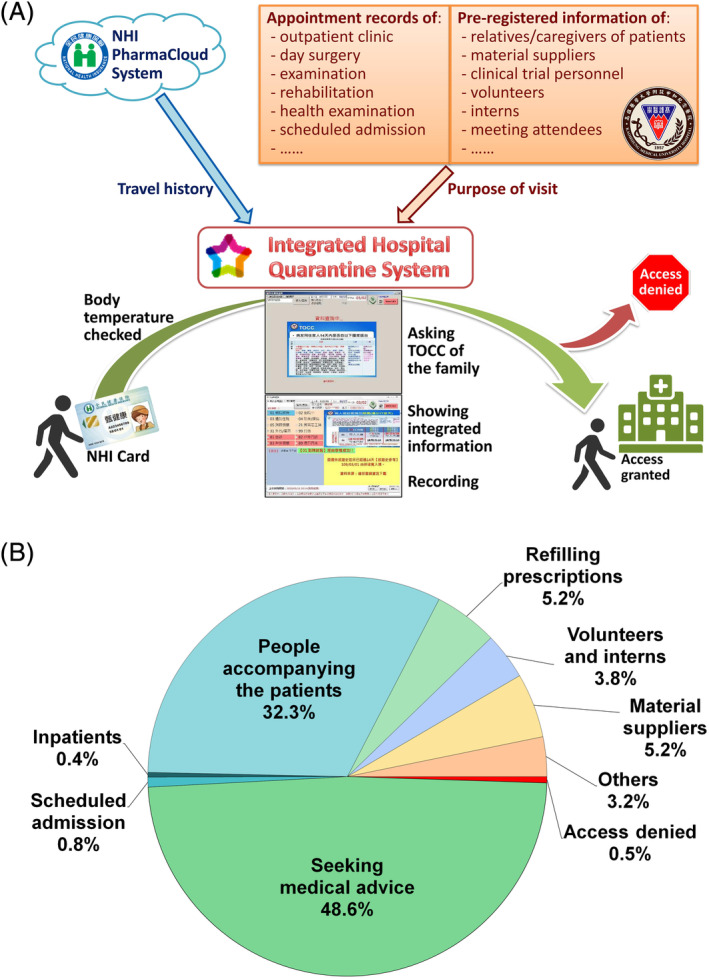Dear Editor,
Coronavirus disease 2019 (COVID‐19), is an emerging infectious disease caused by SARS‐CoV‐2. Hospitals are important fortresses in the war against emerging infectious disease epidemics. The mortality rate might increase dramatically if the healthcare system collapses with the spread of diseases in hospitals. As the case number of COVID‐19 has increased rapidly in nearly all areas of the world, protecting hospitals against intrusion of COVID‐19 is therefore imperative. 1 As many hospitals in Taiwan, our hospital, a large medical center in southern Taiwan, has great experience in infection control, mainly from the epidemic of severe acute respiratory syndrome (SARS) in 2013.
After the first case of COVID‐19 in Taiwan was announced, we rapidly adopted several strategies to ensure our hospital safety, and the most important was the setup of quarantine stations at the entrances. All people were asked to wear surgical masks, sanitize hands, and have their body temperature checked at a quarantine station. Then, their travel, occupation, contact, and cluster histories (TOCC) were requested and recorded electronically. Those with fever or high‐risk findings in TOCC were not allowed to enter the hospital main building and were referred to an outdoor clinic or the emergency department. In collaboration with the Ministry of the Interior National Immigration Agency, the National Health Insurance (NHI) Administration has uploaded all immigration information into the NHI PharmaCloud System, 2 from which we can easily double‐check any visitors' travel history.
The strategies of our hospital were modified according to the latest information about the epidemic. A list of high‐risk areas/countries was updated daily, and we strictly restricted the numbers of visitors from the beginning of March 2020. It then became quite difficult for staffs at the quarantine station to memorize the constantly‐updated information and quarantine policies; in addition, the information from the NHI PharmaCloud System, as well as visitors' purposes for entering the hospital, could not be easily recorded into our hospital information system, making it quite difficult to trace the records.
To facilitate the quarantine process, we developed an Integrated Hospital Quarantine System (IHQS) (Figure 1A and Figure S1 in the Supporting Information). To check the purposes of any visit, IHQS obtains appointment records of outpatient clinics, day surgery, scheduled examination, rehabilitation, health examination, scheduled admission, and so on; it also obtains the information of visitors, such as relatives/caregivers of patients, material suppliers, clinical trial personnel, volunteers, interns, and meeting attendees, which is pre‐registered in a designated database. The travel history is also downloaded from the NHI PharmaCloud System.
FIGURE 1.

A, Using the Integrated Hospital Quarantine System (IHQS) to facilitate the quarantine process at the entrances. B, The purposes and dispositions of quarantine (data from March 13 to March 17, 2020, excluding weekends)
A list of high‐risk areas/countries is displayed while the system is obtaining information, assisting our staff members to ask about the travel history of the patients' family; meanwhile, our latest quarantine policy is displayed to facilitate dividing the patient flow. All information and final decisions are recorded automatically. With the assistance of IHQS, about 0.5% of visitors were denied entry to the main hospital building (Figure 1B).
Our systems have demonstrated the utility of information technology to improve workflow and patient care in hospitals. Our innovative strategies continue to help ensure the safety of our patients and healthcare workers.
CONFLICT OF INTEREST
The authors declare no conflicts of interest.
Supporting information
Figure S1 Screenshots of the Integrated Hospital Quarantine System (IHQS) with comments. A, Screen displayed while searching. B, The main screen with searching results.
REFERENCES
- 1. Chang D, Xu H, Rebaza A, Sharma L, Dela Cruz CS. Protecting health‐care workers from subclinical coronavirus infection. Lancet Respir Med. 2020;8(3):e13. [DOI] [PMC free article] [PubMed] [Google Scholar]
- 2. Wang CJ, Ng CY, Brook RH. Response to COVID‐19 in Taiwan: Big data analytics, new technology, and proactive testing. JAMA. 2020. 10.1001/jama.2020.3151. [DOI] [PubMed] [Google Scholar]
Associated Data
This section collects any data citations, data availability statements, or supplementary materials included in this article.
Supplementary Materials
Figure S1 Screenshots of the Integrated Hospital Quarantine System (IHQS) with comments. A, Screen displayed while searching. B, The main screen with searching results.


